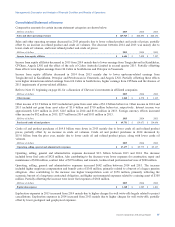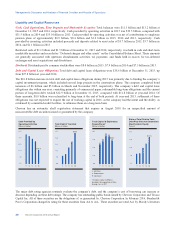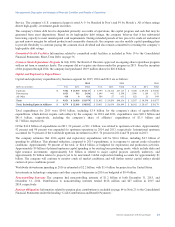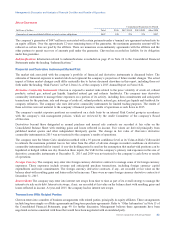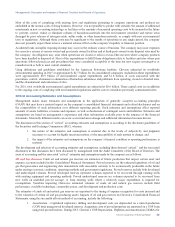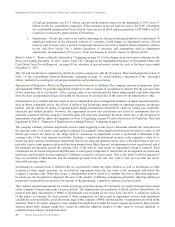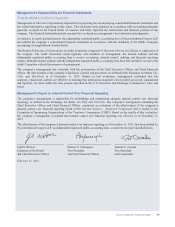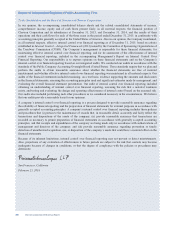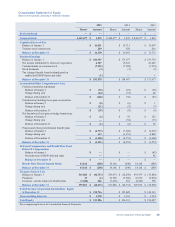Chevron 2015 Annual Report Download - page 28
Download and view the complete annual report
Please find page 28 of the 2015 Chevron annual report below. You can navigate through the pages in the report by either clicking on the pages listed below, or by using the keyword search tool below to find specific information within the annual report.Management’s Discussion and Analysis of Financial Condition and Results of Operations
oil and gas properties was $13.9 billion, and proved developed reserves at the beginning of 2015 were 4.7
billion barrels for consolidated companies. If the estimates of proved reserves used in the UOP calculations
for consolidated operations had been lower by 5 percent across all oil and gas properties, UOP DD&A in 2015
would have increased by approximately $730 million.
2. Impairment - Oil and gas reserves are used in assessing oil and gas producing properties for impairment. A
significant reduction in the estimated reserves of a property would trigger an impairment review. Proved
reserves (and, in some cases, a portion of unproved resources) are used to estimate future production volumes
in the cash flow model. For a further discussion of estimates and assumptions used in impairment
assessments, see Impairment of Properties, Plant and Equipment and Investments in Affiliates below.
Refer to Table V, “Reserve Quantity Information,” beginning on page 74, for the changes in proved reserve estimates for the
three years ending December 31, 2015, and to Table VII, “Changes in the Standardized Measure of Discounted Future Net
Cash Flows From Proved Reserves” on page 80 for estimates of proved reserve values for each of the three years ended
December 31, 2015.
This Oil and Gas Reserves commentary should be read in conjunction with the Properties, Plant and Equipment section of
Note 1 to the Consolidated Financial Statements, beginning on page 36, which includes a description of the “successful
efforts” method of accounting for oil and gas exploration and production activities.
Impairment of Properties, Plant and Equipment and Investments in Affiliates The company assesses its properties, plant
and equipment (PP&E) for possible impairment whenever events or changes in circumstances indicate that the carrying value
of the assets may not be recoverable. If the carrying value of an asset exceeds the future undiscounted cash flows expected
from the asset, an impairment charge is recorded for the excess of carrying value of the asset over its estimated fair value.
Determination as to whether and how much an asset is impaired involves management estimates on highly uncertain matters,
such as future commodity prices, the effects of inflation and technology improvements on operating expenses, production
profiles, and the outlook for global or regional market supply-and-demand conditions for crude oil, natural gas, commodity
chemicals and refined products. However, the impairment reviews and calculations are based on assumptions that are
generally consistent with the company’s business plans and long-term investment decisions. Refer also to the discussion of
impairments of properties, plant and equipment in Note 16 beginning on page 49 and to the section on Properties, Plant and
Equipment in Note 1, “Summary of Significant Accounting Policies,” beginning on page 36.
The company routinely performs impairment reviews when triggering events arise to determine whether any write-down in
the carrying value of an asset or asset group is required. For example, when significant downward revisions to crude oil and
natural gas reserves are made for any single field or concession, an impairment review is performed to determine if the
carrying value of the asset remains recoverable. Similarly, a significant downward revision in the company’s crude oil or
natural gas price outlook would trigger impairment reviews for impacted upstream assets. Also, if the expectation of sale of a
particular asset or asset group in any period has been deemed more likely than not, an impairment review is performed, and if
the estimated net proceeds exceed the carrying value of the asset or asset group, no impairment charge is required. Such
calculations are reviewed each period until the asset or asset group is disposed of. Assets that are not impaired on a held-and-
used basis could possibly become impaired if a decision is made to sell such assets. That is, the assets would be impaired if
they are classified as held-for-sale and the estimated proceeds from the sale, less costs to sell, are less than the assets’
associated carrying values.
Investments in common stock of affiliates that are accounted for under the equity method, as well as investments in other
securities of these equity investees, are reviewed for impairment when the fair value of the investment falls below the
company’s carrying value. When this occurs, a determination must be made as to whether this loss is other-than-temporary,
in which case the investment is impaired. Because of the number of differing assumptions potentially affecting whether an
investment is impaired in any period or the amount of the impairment, a sensitivity analysis is not practicable.
The company reported impairments for certain oil and gas properties during 2015 primarily as a result of downward revisions
in the company’s longer-term crude oil price outlook. The impairments were primarily in Brazil and the United States. No
material individual impairments of PP&E or Investments were recorded for the years 2014 and 2013. A sensitivity analysis
of the impact on earnings for these periods if other assumptions had been used in impairment reviews and impairment
calculations is not practicable, given the broad range of the company’s PP&E and the number of assumptions involved in the
estimates. That is, favorable changes to some assumptions might have avoided the need to impair any assets in these periods,
whereas unfavorable changes might have caused an additional unknown number of other assets to become impaired, or
resulted in larger impacts on impaired assets.
26 Chevron Corporation 2015 Annual Report



